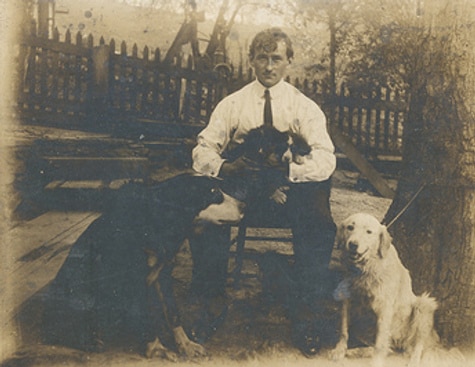
The bond between man and dog has grown over tens of thousands of years. A dog provides a special sort of companionship that’s hard to have with people. They can be unconditionally loyal and loving. A good dog will be there to lick your wounds even when everyone else in your life leaves you. You can talk to your dog about your problems and he’ll just sit and listen without interrupting or judging you. When you have a rough day at work, you can always count on your dog to be waiting for you at the door anxious to get outside and brighten your day. A hunting dog will sit with you in a cold and wet duck blind for hours without whining. Some men even take their dog on a canoe trip.
Moreover, some dogs can provide protection to you and your family. Ever loyal, dogs are even willing to sacrifice their lives for yours. Dogs are truly man’s best friend. But how do you pick your friend? Just like you wouldn’t get into a serious relationship without a good amount of reflection, you shouldn’t choose a dog impulsively. You have to do your homework. Below we’ve created a guide that gives you a rundown on some of the manliest breeds of dogs. These are some of the breeds best suited for the title “man’s best friend,” because they’ve been working, playing, and walking by man’s side for centuries. Whether helping their master land his next meal, faithfully guarding home and hearth, or directing a shepherd’s flock, these dogs have been man’s most loyal companions.
Choosing Your Canine Companion
While it’s tempting to choose a dog based on their size, appearance, or the memory of being choked up during Old Yeller, this isn’t the best way to choose your new best friend. Every dog breed has a unique history. Over a period of many years, breeders continuously refined the breed, selecting for certain practical and aesthetic attributes. Thus each breed has special characteristics hardwired into their DNA. So when choosing a dog, your best bet it to pick one whose characteristics best line up with your personality and lifestyle. A man who is seldom home and who has little time for getting outside should not choose a breed that must be exercised vigorously each day. Likewise, a man who is seeking a jogging companion should not pick low energy dog. Of course even dogs within the same breed have unique personalities and quirks, and to a certain extent, every dog can be trained in such a way as to somewhat mitigate their less desirable traits. But in the balance between nature versus nurture, it’s the former that will give you the best idea on what kind of companion you will be adopting.
A Note on the Working/Obedience Intelligence Score: These numbers are based on a book by Stanley Coren, aptly titled, The Intelligence of Dogs. The author ranked the dogs according to their ability to understand new commands and obey the first command. Some dogs which have a stubborn streak find themselves lower on this list. But it’s important to note that while this propensity for being strong-willed does make training more difficult, it doesn’t mean the dogs are hopeless or hopelessly dumb. Many will respond well if trained with positive reinforcement techniques rather than the traditional punishment style. On Coren’s list, the lower the number, the more intelligent the dog:
- 1-10 Brightest Dogs
- 11-26 Excellent Working Dogs
- 27-39 Above Average Working Dogs
- 40-54 Average Working/Obedience Intelligence
- 55-69 Fair Working/Obedience Intelligence
- 70-79 Lowest Degree of Working/Obedience Intelligence
The Dogs
Golden Retriever
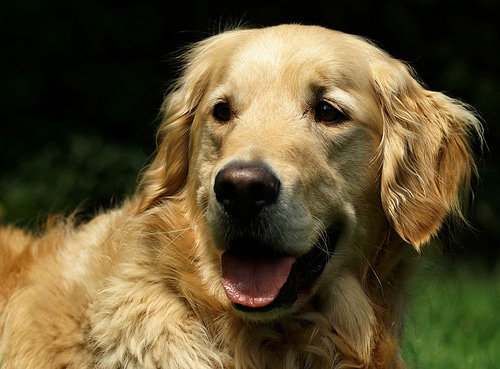
Image by fiona j
Golden Retrievers were bred to be vigorous swimmers, able to recover from the water fish and ducks their faithful owners had shot from the sky. Today’s Golden Retrievers are still adept at this task, whether you want them to retrieve a downed duck or a tennis ball. Golden Retrievers are one of the most popular breeds in America, and with good reason. Friendly, playful, obedient, and loyal, they make terrific family dogs and companions. They’re also useful in keeping safe your family’s secret recipe for baked beans.
Care: Golden Retrievers require ample exercise and interaction with humans. Naturally they enjoy retrieving games immensely, retrieving games that involve the water best of all. Quite intelligent, they can easily learn many commands and tricks and are always eager to please their masters. Golden Retrievers are social dogs and do not like being left alone for long periods of time. Their coats should be brushed once or twice weekly, every day when they are shedding heavily.
Working/Obedience Intelligence: 4
Lifespan: 10-13 years
Stats (out of 5 bones)
Energy level: ![]()
![]()
![]()
Exercise requirements: ![]()
![]()
![]()
Playfulness: ![]()
![]()
![]()
![]()
![]()
Affection level: ![]()
![]()
![]()
![]()
![]()
Friendliness towards other dogs: ![]()
![]()
![]()
![]()
![]()
Friendliness toward other pets: ![]()
![]()
![]()
![]()
![]()
Friendliness toward strangers: ![]()
![]()
![]()
![]()
![]()
Ease of training: ![]()
![]()
![]()
![]()
![]()
Watchdog ability: ![]()
![]()
![]()
Protection ability: ![]()
![]()
Grooming requirements: ![]()
![]()
![]()
Cold tolerance: ![]()
![]()
![]()
Heat tolerance: ![]()
![]()
![]()
Labrador Retriever
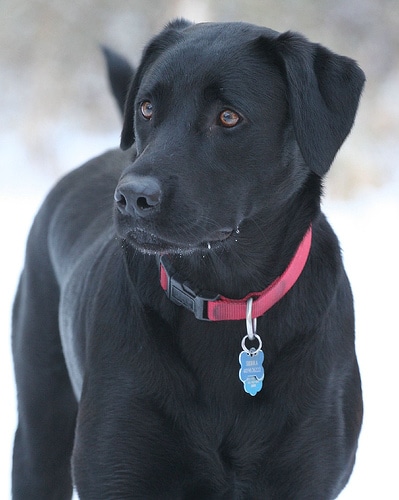
With a sleeker, shorter coat then its Golden cousin, the Labrador Retriever has charmed its way into more American homes than any other breed. Labs are as comfortable in the hunting field as they are back on the homestead. They are calm, gentle, intelligent, and obedient and yet also enjoy a good playful romp in the backyard. Friendly and social, they enjoy the company of humans immensely and are typically kind to other dogs and pets. Their loyalty and dependability have made them a useful “working dog” (for the blind, disabled, ect), and a trustworthy companion for any man.
Care: Labs need ample daily exercise and have a nearly insatiable appetite for human interaction. It is best to allow them frequent times of swimming and retrieving, as this is what they like best. They are an easy-going breed and not generally prone to aggressive, compulsive, or destructive behaviors. Intelligent dogs, they are easy to train, although one must be sure to keep their fun-loving boisterousness from getting out of hand. They love to eat, and owners must be careful to keep their weight in check. Their coats need to be brushed once weekly.
Working/Obedience Intelligence: 7
Lifespan: 10-12 years
Stats:
Energy level:![]()
![]()
![]()
![]()
Exercise requirements: ![]()
![]()
![]()
Playfulness: ![]()
![]()
![]()
![]()
![]()
Affection level:![]()
![]()
![]()
![]()
![]()
Friendliness towards other dogs: ![]()
![]()
![]()
![]()
Friendliness toward other pets: ![]()
![]()
![]()
![]()
![]()
Friendliness toward strangers: ![]()
![]()
![]()
![]()
![]()
Ease of training:![]()
![]()
![]()
![]()
![]()
Watchdog ability: ![]()
![]()
![]()
![]()
Protection ability: ![]()
![]()
Grooming requirements: ![]()
![]()
Cold tolerance: ![]()
![]()
![]()
![]()
Heat tolerance: ![]()
![]()
![]()
Pointer

Pointers are the blue-bloods of the hunting breeds. The very first Westminster dog shows were held primarily for the showing of Pointers, and today they continue to be ranked highly by the American Kennel Club. The Pointer was originally bred to stop and point to birds and rabbits as the hunter readied his shot. Gentle, loyal, and affectionate, Pointers can live long lives and provide an active and athletic companion for an equally energetic man.
Care: Pointers are extremely active dogs, and if not given plenty of exercise, they will become irritable and prone to damaging your stuff. They need at least an hour of exercise each day, preferably in the form of hunting, running, and searching. They like to run for long distances and make good jogging companions. They can live outside in temperate climates but are happiest living indoors with a family. If living indoors, they need ready access to a well-fenced (Pointers like to roam) backyard. Pointers are non-territorial and get along well with others pets. Grooming is easy; their short coat only requires an occasional brushing.
Working/Obedience Intelligence: 17
Lifespan: 12-17 years
Stats:
Energy level: ![]()
![]()
![]()
![]()
Exercise requirements: ![]()
![]()
![]()
![]()
Playfulness: ![]()
![]()
![]()
![]()
Affection level: ![]()
![]()
![]()
![]()
Friendliness towards other dogs: ![]()
![]()
![]()
![]()
Friendliness towards other pets: ![]()
![]()
![]()
![]()
Friendliness toward strangers: ![]()
![]()
![]()
Ease of training: ![]()
![]()
![]()
Watchdog ability: ![]()
![]()
![]()
![]()
Protection ability: ![]()
![]()
![]()
Grooming requirements: ![]()
Cold tolerance: ![]()
![]()
![]()
Heat tolerance: ![]()
![]()
![]()
Bloodhounds
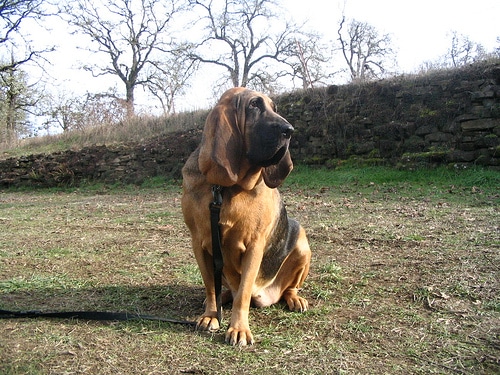
The Bloodhound is of course most famous for its keen sense of smell. Their nose helps take a bite out of crime with its ability to track a human scent that’s days old for several miles. As one might expect from that long droopy face, Bloodhounds aren’t too playful. But they are quite gentle and even-tempered, with the exception of their propensity for busting into your neighbor’s house and gobbling up the Christmas turkey, fresh out of the oven. While Bloodhounds are faithful companions, you may want to keep in mind that due to their susceptibility to “the bloat,” they have on average one of the shortest life expectancies of all dogs at 6.7 years.
Care: Despite the popular of image of the hound dog lazing the day away on the front porch, this breed does like to be active. Their propensity for following a scent trail can make them more difficult to obedience train. They also need more hands on grooming: drool must be cleaned daily from the folds of their faces, and their ears also need regular cleaning. Grooming of the coat is easy; only an occasional brushing is needed.
Working/Obedience Intelligence: 74
Lifespan: 6-10 years
Stats:
Energy level: ![]()
![]()
![]()
Exercise requirements: ![]()
![]()
![]()
Playfulness: ![]()
Affection level: ![]()
![]()
![]()
![]()
![]()
Friendliness towards other dogs: ![]()
![]()
![]()
Friendliness towards other pets: ![]()
![]()
![]()
![]()
![]()
Friendliness toward strangers: ![]()
![]()
![]()
Ease of training: ![]()
Watchdog ability: ![]()
![]()
![]()
![]()
Protection ability: ![]()
Grooming requirements: ![]()
Cold tolerance: ![]()
![]()
![]()
Heat tolerance: ![]()
![]()
Boxer

Boxers developed from two breeds, one of which, the Bullenbeiser, was designed to be a hunting dog that would chase after wild prey and hold onto the animals with its mouth until the master arrived. Thus the boxer developed a very strong jaw and a withdrawn nose that allowed it to breath while its mouth was so engaged. But despite that fierce looking face, boxers are not aggressive or viscous by nature. They are playful, energetic, and attentive. Their strong loyalty and devotion make them an excellent companion.
Care: Boxers need a good amount of daily exercise to keep them happy and not chewing up your things. They have a reputation for being stubborn, but with good training can be quite responsive to commands. Boxers don’t tolerate heat well and aren’t a good dog to keep mostly outside. But if you keep them indoors, be aware that some do snore. Only an occasional brushing of the coat is needed.
Working Obedience/Intelligence: 48
Lifespan: 8-10
Stats:
Energy level: ![]()
![]()
![]()
![]()
![]()
Exercise requirements: ![]()
![]()
![]()
Playfulness: ![]()
![]()
![]()
![]()
![]()
Affection level: ![]()
![]()
![]()
![]()
![]()
Friendliness towards other dogs: ![]()
![]()
![]()
Friendliness towards other pets: ![]()
![]()
![]()
Friendliness toward strangers: ![]()
![]()
![]()
Ease of training: ![]()
![]()
![]()
Watchdog ability: ![]()
![]()
![]()
Protection ability: ![]()
![]()
![]()
![]()
![]()
Grooming requirements: ![]()
Cold tolerance: ![]()
![]()
Heat tolerance: ![]()
Boston Terrier
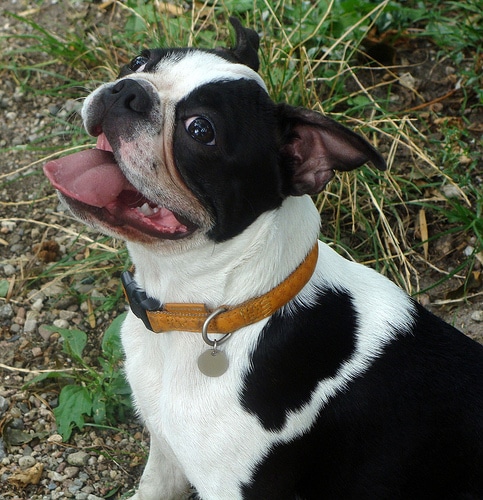
Boston Terriers are a recent breed, and are a mixture of English Terrier and bulldog. Because of their distinct coloring and well-mannered bearing, their nickname is “The American Gentleman.” While they are typically laid-back, they can be quite playful if given the chance. Boston Terriers are alert and lively and have expressive personalities. Yet they are also gentle and sensitive to their owners’ desires and moods.
Care: A Boston’s Terrier’s need for exercise is not great and can be met with a short walk each day. It enjoys social interaction and games with humans. Some are prone to barking, wheezing, and snoring. They do best in a mild climate that is not excessively cold or hot. Coat care is minimal.
Working Obedience/Intelligence: 57
Lifespan: 12-15
Stats:
Energy level: ![]()
![]()
![]()
Exercise requirements: ![]()
Playfulness: ![]()
![]()
![]()
Affection level: ![]()
![]()
![]()
Friendliness towards other dogs: ![]()
![]()
![]()
Friendliness toward other pets: ![]()
![]()
![]()
![]()
Friendliness toward strangers: ![]()
![]()
![]()
Ease of training: ![]()
![]()
![]()
Watchdog ability: ![]()
![]()
![]()
![]()
![]()
Protection ability: ![]()
Grooming requirements: ![]()
Cold Tolerance: ![]()
Heat Tolerance: ![]()
Doberman Pinscher
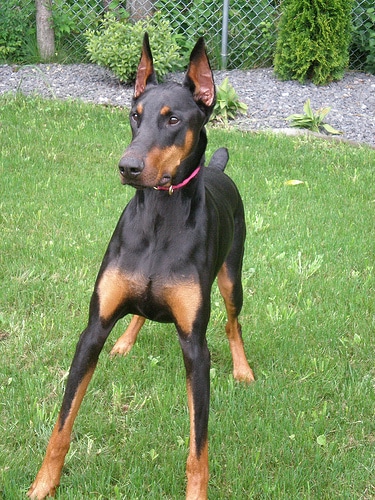
If you see a “Beware of Dog,” sign, what dog do you instantly imagine being behind that fence? Chances are your mind is sobered up by the thought of a Doberman Pinscher. Bred to be lean, mean guard dogs, Dobermans may not be jonesing to snatch a Frisbee out of the air, but they will keep you and your family safe and frighten away annoying door to door salesmen. While they can be quite intimidating, some lines of the breed have been bred in recent decades to be calmer and gentler. And Dobermans can make appropriate family dogs; they’ll scare away strangers, but they won’t eat your baby.
Care: Dobermans’ strong physicality is matched by a keen intelligence. They therefore need both physical and mental exercise every day. Their sharp minds and loyal obedience make them easy to train and their sleek coat requires little care. They can be aggressive towards strange dogs.
Working Obedience/Intelligence: 5
Lifespan: 10-12
Stats:
Energy level: ![]()
![]()
![]()
![]()
Exercise requirements: ![]()
![]()
![]()
Playfulness: ![]()
![]()
![]()
Affection level: ![]()
![]()
![]()
Friendliness towards other dogs: ![]()
![]()
Friendliness towards other pets: ![]()
![]()
![]()
Friendliness toward strangers: ![]()
Ease of training: ![]()
![]()
![]()
![]()
![]()
Watchdog ability: ![]()
![]()
![]()
![]()
![]()
Protection ability: ![]()
![]()
![]()
![]()
![]()
Grooming requirements: ![]()
Heat tolerance: ![]()
![]()
![]()
Cold tolerance: ![]()
![]()
![]()
Beagle

For a man’s whose lifestyle is suited to a smaller dog, but who has no desire for a toy-sized yapper, the Beagle makes an excellent compromise. Bred as a hare and rabbit hunter, the beagle has an “aw shucks” sort of cuteness but isn’t dainty. While most are friendly, even-tempered, gentle, and merry, sadly, very few write novels on the typewriter or fly missions against the Red Baron.
Care: People often forget that the beagle is a hound, with the strong sense of smell characteristic of that family. Thus beagles can be hard to train, as they are easily distracted by scents and the determination to follow a trail. They also become bored and distracted easily and thus have one of the lowest scores on the working/obedience intelligence scale. And while they may be gentle, they’re also excitable and noisy, with a tendency to bark and howl at unfamiliar people and things. They don’t need as much exercise as a bigger dog, but regular walks prevent the excess weight gain to which they are prone. Bred as pack animals, they require a lot of social interaction and companionship.
Working Obedience/Intelligence: 72
Lifespan: 12-15
Stats:
Energy level: ![]()
![]()
![]()
Exercise requirements: ![]()
![]()
![]()
Playfulness: ![]()
![]()
![]()
Affection level: ![]()
![]()
![]()
![]()
![]()
Friendliness towards other dogs: ![]()
![]()
![]()
![]()
![]()
Friendliness towards other dogs: ![]()
![]()
![]()
![]()
![]()
Friendliness toward strangers: ![]()
![]()
![]()
![]()
![]()
Ease of training: ![]()
Watchdog ability: ![]()
![]()
![]()
![]()
Protection ability: ![]()
Grooming requirements: ![]()
Heat tolerance:![]()
![]()
![]()
Cold tolerance: ![]()
![]()
![]()
Great Dane
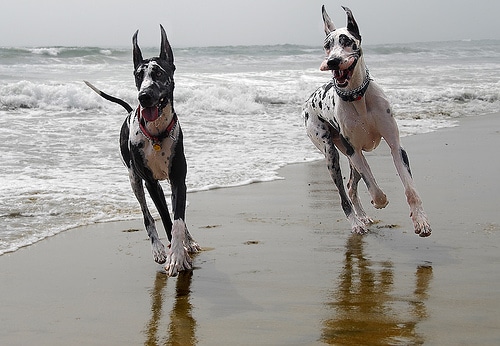
Known as the “Apollo of all Breeds,” a Great Dane can certainly turn heads. They look like small horses and many a kid has imagined riding on this giant dog’s back. But despite their imposing presence, Great Danes are truly “gentle giants.” The fact that it carries its great size with such dignity made it popular with European noblemen of past centuries as a companion, manor guard, and hunting dog capable of taking out wild boar. Then, as now, Great Danes are dependable, spirited, and not prone to excitability.
Care: While they may look like a small horse, they actually don’t need to be exercised like one. Their exercise needs are moderate and can met with a nice walk or play in the park. They will of course need more food than smaller dogs and large indoor spaces (it is not suited for living outdoors) to accompany its size and allow it to spread out when sleeping. The coat requires little care.
Working Obedience/Intelligence: 48
Lifespan: 7-10
Stats:
Energy level: ![]()
![]()
Exercise requirements: ![]()
![]()
Playfulness: ![]()
![]()
Affection level: ![]()
![]()
![]()
![]()
Friendliness towards other dogs: ![]()
![]()
Friendliness toward other pets: ![]()
![]()
Friendliness toward strangers: ![]()
![]()
![]()
![]()
Ease of training: ![]()
![]()
![]()
Watchdog ability: ![]()
![]()
![]()
![]()
Protection ability: ![]()
![]()
![]()
Grooming requirements: ![]()
Heat tolerance: ![]()
![]()
Cold tolerance: ![]()
![]()
Rottweiler

Rottweilers have a long history, going all the way back to ancient Roman times, when they served as cattle drovers and guards. Today they are still desired for their role as protective watchdogs. They are bright, alert, and self-assured. Despite their tough reputation and wariness toward strangers and other dogs, proper training can make a Rottweiler a good companion and family dog.
Care: The ideal Rottweiler owner has experience with dogs and is prepared to offer his pooch steady obedience training, daily mental and physical exercise, and healthy socialization. Responsible ownership is needed to keep the Rottweiler’s natural herding, guarding, and drive for prey in check. The Rottweiler is hearty enough to live outside, provided that ample shelter is provided. But it also needs to spend time indoors socializing with the family. Coat care is minimal.
Working Obedience/Intelligence: 9
Lifespan: 8-11
Stats:
Energy level: ![]()
![]()
![]()
Exercise requirements: ![]()
![]()
![]()
Playfulness: ![]()
![]()
Affection level: ![]()
![]()
Friendliness towards other dogs: ![]()
Friendliness toward other pets: ![]()
Friendliness toward strangers: ![]()
Ease of training: ![]()
![]()
![]()
Watchdog ability: ![]()
![]()
![]()
![]()
![]()
Protection ability: ![]()
![]()
![]()
![]()
![]()
Grooming requirements: ![]()
Cold tolerance: ![]()
![]()
![]()
Heat tolerance: ![]()
![]()
Pug

The pug’s official motto, “Multum in Parvo” ( a lot in a little,) is most befitting. While they are officially a part of the “Toy Group” of breeds, they are the only one of that category to have descended from mastiffs, those ancestors which produced generally massive and manly dogs. Thus the pug is small but not dainty. Originating from China, where it was miniaturized, the pug was popular in the monasteries of Tibetan monks. With a face only a mother could love and an endearingly out-sized personality, these so-called comedians of the dog world are quite the charmers.
Care: While their exercise needs are lower than those for bigger dogs, the pug still needs a decent romp or walk each day. Pugs can be stubborn but are eager to please. They crave social attention and will often follow their owner from room to room. They are therefore not suitable for a man who will be away much of the time and unable to provide sufficient interaction with their pug. Their coat requires minimal care, but the folds of their face must be cleaned daily to avoid skin infections. They do not do well in hot and humid climates. They are prone to snoring and wheezing.
Working Obedience/Intelligence: 57
Lifespan: 12-15
Stats:
Energy level: ![]()
![]()
![]()
Exercise requirements: ![]()
![]()
![]()
Playfulness: ![]()
![]()
![]()
![]()
Affection level: ![]()
![]()
![]()
![]()
Friendliness towards other dogs: ![]()
![]()
![]()
Friendliness toward other pets: ![]()
![]()
![]()
Friendliness toward strangers: ![]()
![]()
Ease of training: ![]()
![]()
![]()
Watchdog ability: ![]()
![]()
![]()
![]()
![]()
Protection ability: ![]()
Grooming requirements: ![]()
![]()
Cold tolerance: ![]()
![]()
![]()
Heat tolerance: ![]()
Bulldog
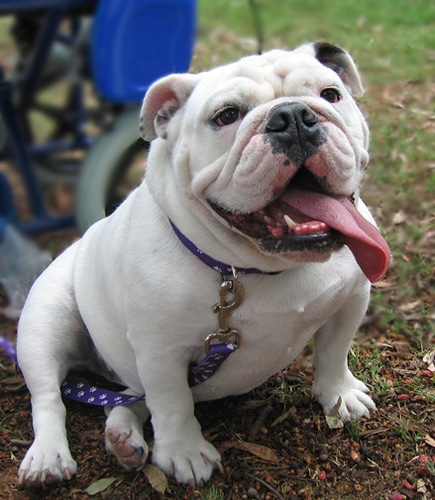
Bulldogs were used for bullbaiting in the 17th century. The bulldog’s job was to latch on to the bull’s snout to prevent it from breathing and to generally get the bull riled up. When bullbaiting became illegal, the bulldog was bred to be more amiable and less violent. Despite this softening, it’s steadfast character has made it a popular collegiate mascot and the official symbol of England. But while it’s still portrayed as a tough and fierce dog in popular culture (often wearing a spiked collar, ala the Georgetown Hoyas), the bulldog’s gruff, unmistakable mug belies its jovial and friendly nature.
Care: Although typically quite laid-back, they can sometimes be stubborn. The bulldog’s exercise requirements are minimal and it’s not suited for running or walking long distances. Most also cannot swim. Coat care is minimal but the fold of their faces should be cleaned daily. Bulldogs don’t do well in excessively cold or hot temperatures.
Working Obedience/Intelligence: 58
Lifespan: 8-12
Stats:
Energy level: ![]()
Exercise requirements: ![]()
Playfulness: ![]()
![]()
![]()
![]()
Affection level: ![]()
![]()
Friendliness towards other dogs: ![]()
Friendliness towards other dogs: ![]()
![]()
![]()
![]()
Friendliness toward strangers: ![]()
![]()
![]()
![]()
Ease of training: ![]()
![]()
Watchdog ability: ![]()
Protection ability: ![]()
![]()
Grooming requirements: ![]()
![]()
Cold tolerance: ![]()
Heat Tolerance: ![]()
Saint Bernard

The Saint Bernard has perhaps the most honorable history of all the breeds. For 300 years, these large dogs tromped though the snowy mountains between Switzerland and Italy looking for lost travelers. When they would locate one, they would lick the frozen person’s face and lay beside them to warm up their body. In this way they saved over 2000 lives. The Saint Bernard of today is different from these life-saving dogs, as they were later bred with Newfoundlands. But Saint Bernards are still devoted dogs who are eager to please their masters. And with proper training, you can teach them to bring you some ale from that little keg around their necks.
Care: Saint Bernards can be stubborn and unruly and thus steady obedience training and ample socialization from puppyhood to adulthood is important. Given their snowy history, they do best in cold climates and are not well-suited for heat and humidity. They can live outside in temperate places. Their coats need weekly brushing. Daily exercise is important; a moderate walk each day will do.
Working Obedience/Intelligence: 65
Lifespan: 8-10
Stats:
Energy level: ![]()
![]()
Exercise requirements: ![]()
![]()
Playfulness: ![]()
![]()
![]()
Affection level: ![]()
![]()
![]()
![]()
Friendliness towards other dogs: ![]()
![]()
![]()
Friendliness towards other pets: ![]()
![]()
![]()
![]()
Friendliness toward strangers: ![]()
![]()
![]()
Ease of training: ![]()
![]()
![]()
Watchdog ability: ![]()
![]()
Protection ability:![]()
Grooming requirements: ![]()
![]() (smooth)
(smooth) ![]()
![]()
![]() (long)
(long)
Cold tolerance: ![]()
![]()
![]()
![]()
![]()
Heat tolerance: ![]()
Siberian Husky

Even if you don’t plan on mushing your way across Alaska, the Siberian Husky makes an excellent faithful companion. Bred as a sled dog, this Arctic breed is always up for adventure. Siberian Huskies are clever, mischievous, stubborn, and playful. They also happen to be the mascot of Brett’s high school alma mater. Go Huskies!
Care: As befitting a dog that came out of Siberia, the Husky has a very thick coat of fur, with both a undercoat and overcoat. Its coat therefore needs to be brushed once or twice a week, daily when they are shedding. Like the wolves from whom they descended, they may howl and “sing.” Their breeding as sled dogs makes them want to run and roam for long distances and they should be given plenty of time each day to do so. The Siberian Husky can be stubborn and independent and benefits from daily obedience training. They are social dogs that need the companionship of humans or other dogs. For obvious reasons, they do best in cold weather climates.
Working Obedience/Intelligence: 45
Lifespan: 11-13
Stats:
Energy level: ![]()
![]()
![]()
Exercise requirements: ![]()
![]()
![]()
![]()
Playfulness: ![]()
![]()
![]()
![]()
Affection level: ![]()
![]()
![]()
![]()
Friendliness towards other dogs: ![]()
![]()
![]()
Friendliness toward other pets: ![]()
![]()
![]()
Friendliness toward strangers: ![]()
![]()
![]()
![]()
![]()
Ease of training: ![]() Watchdog ability:
Watchdog ability: ![]()
![]()
![]()
Protection ability: ![]()
Grooming requirements: ![]()
![]()
![]()
Cold tolerance: ![]()
![]()
![]()
![]()
![]()
Heat tolerance: ![]()
Dalmatians
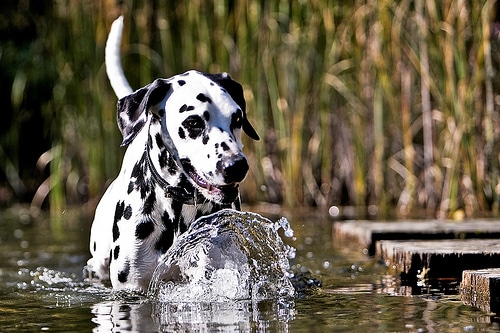
Image by sputnik
Serving at various times in history as war dog, sentinel, shepherd draft dog, trail hound, retriever, bird dog, and circus dog, the Dalmatian is a truly versatile breed. However they really found their niche in Victorian England as coach dogs, whose job it was to trot handsomely next to the coach and protect the horses from other dogs. They also served this function for horse-drawn fire engines, and thus became a common firehouse mascot. Dalmatians are playful, energetic, and eager for companionship.
Care: Many would-be dog owners are drawn to the Dalmatian’s distinct coat, but as the media always warns whenever a new Dalmatian-themed movie comes out– this dog may be cute, but it’s not for everyone. It is suited only for an active man is who prepared to go beyond a couple of walks each day and give the dog the hard, vigorous exercise it needs to be happy and well-behaved. Dalmatians like to run and roam for miles and it makes an excellent jogging companion. Dalmatians do have a genetic disposition for deafness, and a deaf dog will of course have special needs.
Working Obedience/Intelligence: 39
Lifespan: 12-14
Stats
Energy level: ![]()
![]()
![]()
![]()
Exercise requirements: ![]()
![]()
![]()
Playfulness:![]()
![]()
![]()
Affection level: ![]()
![]()
![]()
![]()
![]()
Friendliness towards other dogs: ![]()
![]()
![]()
Friendliness towards other pets: ![]()
![]()
![]()
Friendliness toward strangers: ![]()
![]()
![]()
Ease of training:![]()
![]()
![]()
Watchdog ability: ![]()
![]()
![]()
![]()
Protection ability: ![]()
![]()
![]()
Grooming requirements: ![]()
![]()
![]()
Cold tolerance: ![]()
![]()
![]()
Heat tolerance:![]()
![]()
![]()
Border Collie
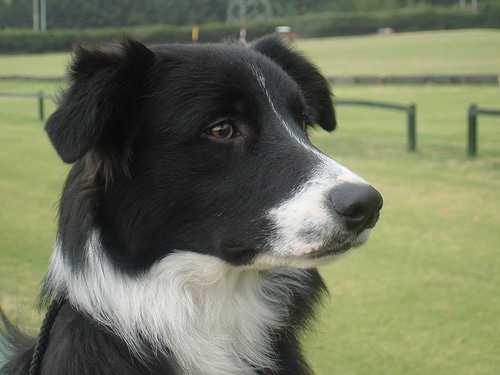
Image by agrosrev
Bred for more than a century with an eye towards function over appearance, the Border Collie is considered the most intelligent dog in the world. It’s use as a sheepdog required a keen and obedient mind. Now a popular household dog, Border Collies make energetic, faithful, and protective companions for masters willing to meet their needs. Care Like the Dalmatian, the Border Collie is not a dog for every man. Bred to be working dogs, without daily work and exercise they will devolve into a compulsive and destructive pet. Border Collies need a job to do each day, but this need not be herding sheep; games, ball retrieving, and Frisbee catching will appropriately stimulate their keen mind. They make excellent dogs for dog sports and competitions. Border Collies cannot lives in apartments as they need ready access to the outside world. They can live outside in temperate climates but also enjoy socializing with humans indoors. Their long coat needs twice weekly brushing. Working Obedience/Intelligence: 1 Lifespan: 10-14
Stats:
Energy level: ![]()
![]()
![]()
![]()
![]()
![]()
Exercise requirements: ![]()
![]()
![]()
![]()
![]()
Playfulness: ![]()
![]()
![]()
![]()
Affection level: ![]()
![]()
![]()
Friendliness towards other dogs: ![]()
![]()
![]()
Friendliness towards other pets: ![]()
![]()
![]()
Friendliness toward strangers: ![]()
![]()
Ease of training: ![]()
![]()
![]()
![]()
![]()
Watchdog ability: ![]()
![]()
![]()
![]()
Protection ability: ![]()
![]()
![]()
Grooming requirements: ![]()
![]()
![]()
Cold tolerance: ![]()
![]()
![]()
Heat tolerance: ![]()
![]()
![]()
German Shepherd
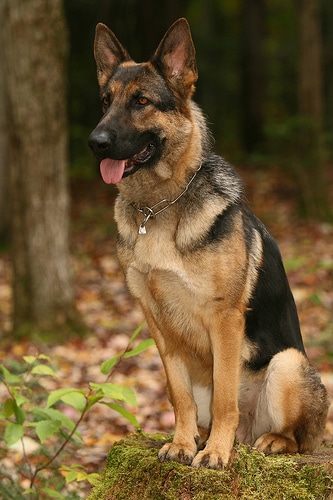
The German Shepherd is a recent breed, carefully bred to be the consummate sheep herder. Yet the qualities prized for such work- strength, obedience, intelligence, and loyalty-have today made it a versatile working dog and a valued pet. The German Shepherd is often employed as police dog, guard dog, guide dog, and search and rescue dog. As a household pet, the German Shepherd is devoted to and highly protective of its owner and family.
Care: German Shepherds have a reputation for aggressiveness that is not entirely unearned. This breed leads all others in the random biting of humans and they are often aggressive toward other dogs. Proper socialization and training can curb this tendency. German Shepherds are at their best when given ample exercise and the feeling of having a purpose. The coat must be brushed once or twice a week.
Working Obedience/Intelligence: 3
Lifespan: 10-12 years
Stats:
Energy level: ![]()
![]()
![]()
Exercise requirements: ![]()
![]()
![]()
![]()
Playfulness: ![]()
![]()
Affection level: ![]()
![]()
![]()
Friendliness towards other dogs: ![]()
Friendliness towards other pets: ![]()
![]()
![]()
Friendliness toward strangers: ![]()
![]()
Ease of training: ![]()
![]()
![]()
![]()
![]()
Watchdog ability: ![]()
![]()
![]()
![]()
![]()
Protection ability: ![]()
![]()
![]()
![]()
![]()
Grooming requirements: ![]()
![]()
Heat tolerance: ![]()
![]()
![]()
Cold tolerance: ![]()
![]()
![]()
Basset Hound
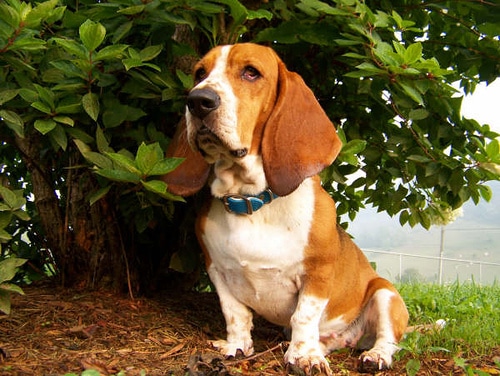
Image by helen’s bassets
The Basset Hound was developed after the French Revolution for commoners who wanted a dog with a keen sense of smell, but which had short legs suited for a slower pace of hunting.
Care: With a nose second only to the bloodhound, the Basset Hound is fond of tracking and is hard to stop from following a trail once he’s picked up the scent. They thus can be stubborn when it comes to obedience training. Their droopy face creates some extra care needs. Their droopy eyes build up with gook and need to be cleaned daily to avoid irritation. Their equally droopy ears get dragged into various things and are prone to ear infections. They also drool and need the folds of their faces cleaned regularly. Their exercise requirements are not great and can be met with a daily walk.
Working Obedience/Intelligence: 71
Lifespan: 8-12
Stats:
Energy level: ![]()
![]()
Exercise requirements: ![]()
![]()
Playfulness: ![]()
![]()
Affection level: ![]()
![]()
![]()
![]()
Friendliness towards other dogs: ![]()
![]()
![]()
Friendliness towards other pets: ![]()
![]()
![]()
Friendliness toward strangers: ![]()
![]()
![]()
Ease of training: ![]()
![]()
Watchdog ability: ![]()
![]()
![]()
Protection ability: ![]()
Grooming requirements: ![]()
![]()
Heat tolerance: ![]()
![]()
![]()
Cold tolerance: ![]()
![]()
![]()
Mutt

Ah, the loveable mutt. They’re not winning any medals at the Westminster Dog Show, but a mixed breed dog can provide companionship just as well as those blue blooded full breed dogs. If you’re looking for a dog, but can’t afford the sometimes exorbitant prices for a full breed, consider a mutt. You can find plenty of good mutts at your local pet adoption center that are in need of a good home. You can also find them very often being given away as pups from an owner who got a surprise litter from their mangy mutt. Best of all, they’re scrappy, just like you.
Care/Working Obedience/Intelligence:/Lifespan/Stats: Results may vary. We’ll level here: it’s a crapshoot.
__________________________
Source: The Encyclopedia of Dog Breeds by D. Caroline Coile Ph.D


